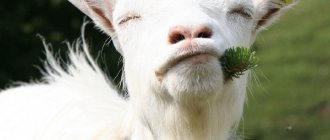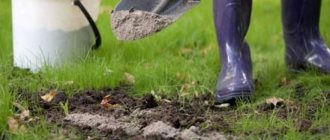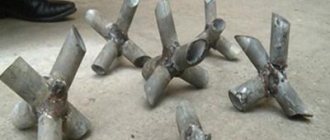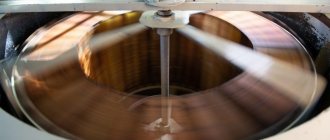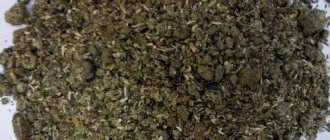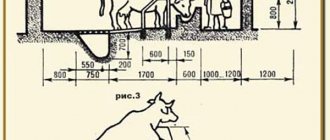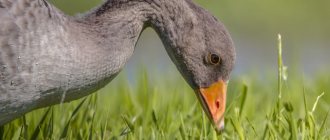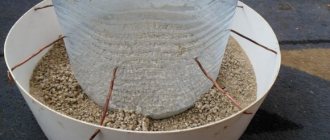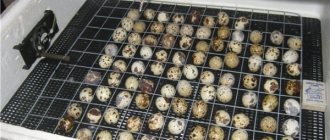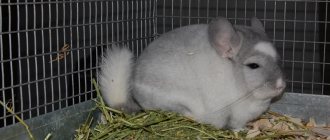If you want to save money several times and get a feeder and waterer that are ideal for a specific pigeon coop, you should figure out how to make such equipment with your own hands. There are many types of feeders and drinkers, but we will analyze the most optimal and universal ones, taking into account the proportionality of sizes and volumes.
Basic requirements for pigeon feeders
Each feeder must meet certain standards, which makes the process of caring for and feeding birds easier. Convenience of eating creates comfort for the birds, cleanliness eliminates the risk of disease. Size is considered important, since adults and young animals need feeders with different parameters.
What requirements must be met:
- feed should not be contaminated;
- Maintaining the feeder (cleaning, adding food, etc.) should be simple;
- the body and legs of birds should not come into contact with the food - only the beak;
- grain should not fall out of the feeder;
- the material must be selected environmentally friendly;
- long service life;
- the ability to wash the structure without consequences;
- Direct access to feed is required.
We create conditions for proper content
Before deciding on the model and material from which to build the feeder, you should understand what main requirements a home-made structure must meet.
DIY pigeon feeder option
- birds must have direct access to feed;
- the design must have reliable protection from debris, snow and rain getting onto the feed;
- it should be convenient for the owner of the dovecote to clean the structure;
- Dirt from the paws of birds should not directly fall on the grain.
Whichever option you choose, it should be equipped with a grain tray and a protective cover against snow and debris.
What equipment and materials will be needed?
When making feeders at home, you are unlikely to need special expensive equipment. It is enough to have a primitive set of tools (saw, hammer, nails, etc.) and materials from which the structure is constructed. The most popular materials for beginner pigeon keepers are plastic, cardboard and wood. To choose one of them, you should consider the advantages and disadvantages of each:
- Cardboard is the cheapest and most short-lived material. Pros: there are no difficulties in manufacturing, a minimum supply of tools is required, simplicity of design. Disadvantages: lightness of construction (can be blown away by the wind), fragility (maximum a couple of months), does not withstand precipitation, can only be used in summer.
- Plastic is the most popular and widely available material. Advantages: low cost, availability, minimum tools, resistance to any temperature and precipitation, durability, ease of maintenance. In addition, thanks to the transparency of the plastic, birds can see the presence of food from afar. Disadvantages: the need to make the structure heavier due to the lightness of the material.
- Wood is the most reliable and durable material that will last for many years. You can create absolutely any structure from wood. Among the disadvantages, it is worth noting the relatively high cost (unlike plastic and cardboard) and the need to use additional tools.
Even a beginner can make a pigeon feeder. The main thing is to carefully study the instructions and strictly adhere to all recommendations.
How to choose material for a feeder?
Metal feeders and drinkers are considered the most durable. However, at home you can build a structure from more affordable materials, such as plastic, wood, thick cardboard.
A fairly popular material from which bird feeders are made is plastic. It has several main advantages:
- availability;
- in this design, birds can clearly see the food even from a distance;
- processed without any difficulty;
- does not deform as a result of temperature changes;
- does not involve a large amount of waste;
- there is no need to purchase special equipment for manufacturing the structure;
- Such durable products will last for several years.
You can make a feeder from cut plastic bottles
The only disadvantage of plastic is its low weight, which is why birds often turn over such feeders. To prevent this, the structure should be pre-fixed - for example, if the feeder is made from cut bottles, they can simply be nailed to a wooden base.
Cardboard is a simple and affordable material from which various designs are made. Its main advantages can be highlighted:
- speed of making the feeder;
- You can use any unnecessary box as a basis.
However, the negative aspects of the material should also be highlighted:
- the feeder can be placed in a cage only in summer or spring; in the cold season it immediately becomes deformed from precipitation;
- the design is suitable for use for 1-2 months, so it will have to be replaced regularly;
- since the cardboard is very light, the feeder can be blown away by the wind; to avoid this, you will need to put a weighting agent in the inside;
- Birds can quickly damage this fragile material.
You can use a long and narrow cardboard box as a feeder.
Wood is often used to make bird feeders, because this material has obvious advantages:
- reliability;
- durability (when treated with special solutions or drying oil, it lasts for many years);
- environmentally friendly (the material is absolutely safe for birds).
The only downside is that wooden feeders are more difficult to disinfect than plastic or metal ones. In addition, to manufacture structures you must have certain skills.
Some poultry farmers make structures from galvanized steel. Such feeders have two main disadvantages - you will have to spend money on purchasing metal sheets, and you also need to have certain skills to manufacture them. Otherwise, such a feeder and drinker is the most environmentally friendly, especially compared to plastic, and durable.
Step-by-step instructions for making your own feeders
Wooden feeders
To create a structure made of wood, you will need the following (the parameters are given as an example):
- plywood;
- boards - 4 pieces (two of them are 70x8 cm in size, the remaining ones are 25x20 cm);
- tin;
- wooden block 70 cm long;
- nails;
- slats.
The process of making a feeder in the form of a house:
- Put together a box from boards using fastening nails. The back and side walls should be high. Be sure to nail the cover from the board.
- Make a roof from 2 pieces of plywood, which should protrude above the structure.
- Separately make a pallet (movable) from plywood and slats. It is installed on the bottom of the feeder.
- Attach a weather vane to the roof to scare away birds (so that they don’t land on top).
- Nail a piece of wood so that between it and the bottom there is space for inserting a pull-out tray.
- Tin is needed to create restrictive strips (cut into strips). They are mounted in front of the feeder in a vertical position. They are fixed between the lid and the bar.
Other options for wooden feeders are presented schematically below:
Cardboard feeder
Cardboard products can be made for temporary use (until you can make or purchase a more durable design). For this, you can use cardboard boxes of any size, but it is best to take a device for shoes (compacted cardboard, optimal size). Additionally, you need scissors and tape.
- make holes for the rope in the corners of the lid and bottom;
- thread;
- hang it from a support.
These feeders can be used to feed wild birds in parks and yards.
From a cardboard box:
- give the box the appearance of a house;
- secure with tape;
- make holes for entry.
Such feeders can be hung on the balcony (when keeping pigeons at home) or placed on the floor in the dovecote (in this case, small pebbles must be placed at the bottom of the paper structure, which will serve as weighting devices so that the wind does not rock the structure).
Plastic feeder
For this purpose, 5- or 6-liter plastic bottles are used. They can be installed both vertically and horizontally, after cutting out holes for the birds.
How to make a feeder from a plastic bucket and a plastic bottle, see the video below:
Hopper automatic feeder
This method allows you to control the amount of feed supplied. You can immediately pour a significant amount of grain into such a feeder, which will flow into the feeding compartment as it is emptied. This is convenient if the owner of the dovecote leaves for several days (the pigeons will not go hungry). Feed is supplied automatically.
The design consists of 2 main compartments - a compartment for storing grain and a feeding tray:
How to make the simplest self-replenishing bunker feeder from a plastic bottle is shown in the video below:
Hopper automatic feeder
Every breeder should make such a feeder for pigeons in order to automate the feed supply process. Such models are especially relevant for pigeon breeders who spend most of their time at work or sometimes leave for 1-2 days.
Interesting! The bunker feeder for pigeons is a closed structure for storing grain. It goes to the pigeons as they are emptied.
A simple product is made from plastic bottles:
- The neck of a large plastic water bottle and a small soda or juice bottle is cut off. Then the excess plastic is removed, as in the photo.
- Place a cap on another bottle and draw a marker around the holes (on both sides) for the dispenser. Using a knife, make cuts in the circle that will better fix and protect from moisture.
- A wide hole is drilled in the lid with a drill through which food will flow from the feeder. Dispensers with holes are inserted into holes with slits.
- Using a hot nail, punctures are made under the dispensers and a stick is inserted there (immediately into 2 opposite holes). The stick should be such a length that there is a 10 cm perch on both sides.
- A plastic lid is attached to the bottom of the feeder using self-tapping screws.
The work takes 20–30 minutes. The result is a convenient feeder for pigeons with automatic food supply.
How to make a feeder for pigeons?
It is necessary to create separate feeders for the chicks, from which they will feed after weaning from the nest. This is due to the fact that pigeons experience some stress during this period, so feeding with adults is contraindicated. In addition, the general condition of the chicks is influenced by a change in diet.
To make it we will use a plastic stand from a flower pot, a glass jar and a metal mesh. You will also need wire cutters and some wire.
- Cut a strip of mesh 5 cm wide. The length of the strip should be 2 cm greater than the circumference of the neck of the jar.
- Twist the mesh into a ring and secure with wire. The diameter of the mesh ring should be a couple of millimeters larger than the diameter of the neck of the jar.
- Bite off the twigs of the bottom row of the mesh so that you get vertical pins (see point 1 in the photo below).
- Heat the pins over the fire and press them in the center of the plastic stand (see point 2 in the photo below).
- Bend the pins on the back of the stand (see step 3).
- Fill the jar with grains and insert the neck into the mesh ring, as shown in the photo below. Please note that the neck of the jar does not touch the stand. If it turns out differently for you, then you should re-cut the strip from the mesh, but of a larger size in width.
- Turn the jar over so that the grains fall into the stand. As the food is eaten, a new portion of grains will fall.
How to make a drinking bowl?
Feeding pigeons involves providing them with water, so it is necessary to make a drinking bowl. There are different ways to do this.
Automatic heated drinker
It is used during frosts so that the liquid does not freeze and the birds can always drink. The drinking bowl consists of the following elements: stand; a heating device, a drinking container, a bottle with a dosing tube that is filled with liquid. How to do:
- The container is a round container made of plastic material, in which you need to make a hole on the side through which the pigeons will drink. It should be at a distance of 6-10 cm from the bottom.
- A tin can filled with paraffin is suitable for the burner. A wick must be installed (you can use asbestos rope). Instead of fuel, an ignition agent is used.
- The stand should also be made of tin. A burner is installed on it and ignited. The top is covered with a protective case made of tin, in which several holes must be made (gas exchange is created).
- A plastic drinking bowl with a small weight is installed on top, so it does not tip over. In the upper part of the container, you need to make a round hole the diameter of a 1.5 liter plastic bottle. It is this that is filled with water and inserted into the drinking bowl upside down. A dosing tube is installed inside to prevent liquid from overfilling the drinker. Thus, as the container is emptied, the drinking bowl gradually fills with water.
An example of making another automatic drinker is shown in the video below:
Vacuum drinking bowl
How to make it yourself:
- Use a bowl and glass jar. The diameter of the bowl should be larger than the neck of the jar.
- At the bottom of the bowl, glue four rubber cubes that describe the circumference of the neck of the jar.
- Pour water into a jar, cover it with a bowl and turn the jar upside down. This will allow water to fill the bowl and will flow again as it is emptied.
Homemade feeders are almost as good as factory ones, and making them at home significantly saves money. The main thing is to carefully study all the intricacies of manufacturing structures, adhere to the basic rules and choose the most suitable option among the many models.
Homemade wooden structure
The size of the pigeon feeder depends on the number of pigeons. To make it yourself you will need slats and plywood:
- 20x40 mm – 2 pcs.;
- 20x20 mm – 1 pc.;
- plywood - strip 13 cm wide.
The standard option for a large dovecote is 1.5 m.
2 parts in the shape of a “house” are cut out of plywood. The width of the base is 13 cm, the height to the bevel angle is 17 cm. From this point to the top, measure 5-6 cm. In the upper part, the corner of the “roof” is cut off - a platform 2-3 cm wide is formed (you don’t have to do this).
On the narrow side of strip No. 1, 20x40 mm, markings are made every 5 cm. On strip No. 2, 7.5 cm are retreated from the edge, and then markings are made every 5 cm.
The markings from rail No. 1 are transferred to one side of the narrow 20x20 mm strip and the corresponding mark is made (No. 1) so that you can navigate when assembling the structure. The markings are transferred to the other side from rail No. 2. Holes (not through holes) are made along the marks.
At the next stage, 20x40 mm strips are screwed to the bottom from one and the other edge. Parts in the shape of a “house” are screwed onto the end sides. On each of these parts, 17 cm from the bottom edge in the center, marks are made for a screw. In a 20x20 rail, the center is marked in the end parts. It is screwed in accordance with the marks (No. 1 and No. 2) - the holes at the top and bottom will be at the same level.
Prepare pieces of hardened wire 14 cm long. One end of each piece is inserted into the upper bar, the other into the lower one. The top can be covered with a “roof” by cutting out 2 parts from plywood.
Pigeon drinking bowls
There are several ways to make a drinking bowl for pigeons. Which one to choose depends only on you, more precisely, on the amount of free time and the availability of the necessary materials.
An excellent option is a drinking bowl made of galvanized iron. To make it, you do not need any special skills, but there are still a number of important points that must be taken into account before making a drinking bowl. It is important that its length is optimal for pigeons, because when a bird drinks water, it immerses its head almost completely in the drinking bowl so that the water reaches its eyes. Take this into account, because otherwise the pigeons will decide that your drinking bowl is a great place for swimming and it will be difficult to achieve at least some purity of the water.
The basis of the drinker is a rectangular iron sheet 6 cm wide. The length in this case does not matter. Using pieces of iron, make the walls of the drinking bowl 8 cm high. Secure the resulting structure between two bars on the board.
But if there are a lot of pigeons under your care, then they will drink water from such a drinking bowl too quickly. Therefore, you need a reservoir from which water will flow into the structure as the pigeons consume it. To do this, you need to find a cylindrical container with rolled up sides. The depth of the container is 9 cm. You need to place a plastic bottle in it. Measure 4-5 cm from its bottom edge and make a small hole. Water will flow through it.
Remember that in the hot summer, the pigeons' need for water increases. This is why the risk of water pollution increases.
Failure to comply with sanitary standards can cause infection. The best way out of this situation is to add a little disinfectant solution to the drinking bowl.
Heated drinker: we create it ourselves
In winter, one of the problems is maintaining the temperature in the dovecote. The water quickly freezes, making it impossible for the pigeons to use the drinking bowl.
In this case, the optimal solution would be to create a heated drinking bowl, which will provide direct access to water even in severe frosts.
The drinking bowl will consist of four parts:
- stands;
- drinking container;
- water bottles with dispensed straw;
- heating element.
To create you need the following materials:
- We take a plastic round container and make holes in it with a diameter of 7-8 cm. Carefully process all the edges so as not to injure the birds when drinking. Consider the height of the holes from the bottom - it should be at least 5-6 cm, otherwise it will be uncomfortable for the birds to stick their heads inside.
Holes in container
Make cuts on a tin can
This is what the finished design looks like
You can see the design features in detail in the video.
Video - Automatic drinking bowl for pigeons with heating
Video “Pigeon Feeder”
The author of the video made a bird feeder with his own hands.
Let's look at several ways to make a pigeon feeder.
Method 1. You need two plastic bottles. Their dimensions must be such that one of them can freely fit into the other:
- cut off the neck and bottom of the smaller bottle;
- make a small hole on the side at the bottom (on the side where the neck used to be);
- pour food on top;
- put on a larger piece of bottle.
Method 2. Making such a feeder for pigeons will take more time, but it is particularly reliable. You need four boards: two 700 mm long and 80 mm high, and two more 250 mm long and 200 mm high. Make an ordinary box out of them, taking into account that the side walls should be slightly higher. Nail a block to them that will prevent birds from getting inside the feeder. You can also make a pinwheel on top. It will turn around and the pigeon will get scared and fly away when it tries to sit on the feeder.
Feeder-drinker for pigeons
This is a universal type of feeder, which is made to organize the diet of chicks after you need to discourage them from the nest. Leaving the nest is a huge stress for babies, which is accompanied by changes in nutrition, so they need a feeder of a special design that can be used to pour food and pour water into different compartments at the same time.
In order to make it yourself, you will need some skills in working with tools, free time, as well as wooden boards, some nails, plywood and tin sheets.
- Take small boards and first make the frame of the main bunker, and then the pull-out tray.
- Cover the frame 1 cm with plywood.
- Using small pieces of tin, make access barriers (see the picture for a detailed description of the design and dimensions).
Drawing of homemade wooden feeders for pigeons
General requirements for the equipment of a pigeon feeder
If the feeder is made correctly, then you will have fewer problems with care, since a lot depends on this factor: sanitary cleanliness, the comfort of the birds and the ease of cleaning the dovecote. Of course, you can take a regular container, but for the chicks this will be a real test, and they will be in a state of stress.
It may also happen that you have to be away for some time, and there is no one to ask to look after the dovecote. In this case, this unique dining room for your pets is the optimal solution.
People experienced in breeding pigeons advise separating feeders for adult pigeons and babies. After all, the chicks are unusual in being among adults and experienced individuals, and they will most likely be afraid to even approach the dining room.
There are two types of feeders for our feathered friends:
- automatic;
- boxed
Regardless of what type you want to build, it is important to remember the general requirements for any of them:
- birds must have immediate access to food;
- the constructed structure should well protect the feed from debris and precipitation;
- the design should be such that it is easy to clean;
- dirt from pigeon legs should not fall on the prepared food.
Requirements and parameters of an ideal feeder
A properly selected feeder for pigeons plays an important role when breeding birds. The level of sanitary cleanliness, the comfort of the birds, and the convenience of cleaning the dovecote depend on this.
Of course, you can get by with simple containers into which to pour grain. But for small pigeons that are just leaving the nest, such a feeding regime will be very stressful. In addition, if the owner of a dovecote needs to go away for several days, and there is no one to entrust the farm to, creating such a canteen for birds will be the optimal solution.
What to feed pigeons
The main menu of domestic pigeons is grain and grass, but this is not the entire list of products that can be fed to birds. this article how to choose the right amount of food depending on the breed and correctly formulate the diet
Experienced pigeon breeders recommend creating separate feeders for adults and small pigeons to ensure comfort. After all, small chicks who have just left the nest and are gradually getting used to adult life are still afraid to approach a common feeder together with experienced adults.
Homemade feeders for pigeons
Feeders for birds can be divided into two types:
A box feeder is much easier to make from available materials. At the same time, in terms of ease of maintenance and cleaning, it is not inferior to an automatic one.
In addition, if birds spend a lot of time outside, freely feeding on food from the ground, then the box type will be more familiar to them.
What is best to make it from: choosing the material
The choice of material from which the feeder will be made also plays an important role. Experienced pigeon breeders always choose more durable materials, since they are primarily interested in the durability of the structure. But you can also use less durable materials, such as cardboard or plastic.
To make it easier for you to make a choice, we list the pros and cons of the most popular materials for making a pigeon feeder.
Plastic. One of the most popular options for such a device, which has many advantages:
- easy accessibility;
- due to the transparent walls of the structure, birds will be able to see the food from afar;
- easy to handle;
- minimum trash and waste;
- no special tools are needed to create such a feeder;
- resistance to changes in temperature and humidity;
- The plastic product is quite durable and will last for many years.
The only drawback that is inherent in plastic is its light weight, so the feeder must be well secured.
Cardboard. The advantages of this material:
- ease of work;
- easy accessibility (there is always an unnecessary box in the house).
But, perhaps, such material will have more disadvantages:
- the cardboard structure will not withstand heavy rainfall, so it is only suitable for the warm season (but in case of rain it will have to be removed);
- such a design will not be durable: it will only last for a couple of months;
- the weight of the cardboard feeder will be very light, so to prevent it from being blown away by the wind, you will have to make additional reinforcements and add something to the feeder itself to make it heavier;
- cardboard is not the most durable material and can be easily damaged.
Tree. Its advantages include:
- reliability;
- strength;
- durability (if the tree is also treated with a special solution, for example, drying oil, water-polymer emulsion, etc., the manufactured feeder will serve for many years);
- environmental friendliness.
Wood is probably the best choice in terms of durability and longevity, but making this type of feeder will require additional tools and at least basic woodworking skills.
Materials
Feeders are made from environmentally friendly materials - plastic, metal, wood.
Plastic
This material does not emit toxic substances, the edges are not sharp - the bird cannot get hurt. Plastic containers are hygienic and suitable for all types of feed. Thin-walled feeders are unreliable - pigeons can turn them over, so additional fastening or weighting is required (a weight is placed on the bottom).
Tree
The material is natural, strong, durable. It is well suited for dry food, but wet mash should not be used. The downside is the presence of sharp splinters (splinters) - the surface must be treated with sandpaper to remove all irregularities and smooth the edges.
Metal
Metal is the most reliable material. Metal containers are stable and suitable for all types of feed. Hygiene is easy to maintain - dirt can be easily removed, and if necessary, you can disinfect the surface using a burner. Disadvantage: sharp edges can injure pigeons; be sure to bend the metal edge.
How to make a pigeon feeder with your own hands
Having figured out what types of feeders there are and what material can be used, all that remains is to build them. Let's take a step-by-step look at how to make a wooden, plastic and automatic feeder.
Wooden
So, first we list what we need during the manufacturing process.
Necessary materials:
- 4 middle boards;
- 1 sheet of plywood;
- 4 wooden blocks.
Plastic
Now there is a simpler option - we make a plastic feeder.
Necessary materials:
- two plastic bottles, but always of different capacities (if you have a small dovecote, you can take 2 and 1.5 liter bottles, but if not, then you need to take larger bottles - 10 and 5 liters each).
Required tools:
- knife;
- pencil.
Step-by-step instruction:
- For a smaller bottle, cut off the bottom and neck with a knife.
- From a larger bottle, cut off only the neck and leave the bottom.
- Next, use a pencil to mark a point on the small bottle closer to the neck and make a small hole. We will pour food through it.
- Now you need to put the cut large bottle on the small one. That's all, the feeder is ready.
What to feed pigeons?
If you have not previously raised pigeons or provided them with feeders, you are probably interested in what you can give to pigeons as food. The basis of the diet for pigeons is grain and grass. Grain can be given differently depending on the time of year and other factors.
We list the main types of grains that can be given to pigeons:
- barley (special attention is paid to it during molting);
- pearl barley;
- wheat (its quantity increases during molting and feeding of chicks);
- millet (gives a lot of energy, young animals and sports breeds especially need it);
- shelled oats or oatmeal.
Legumes are also included in the diet of pigeons, but be careful because they lead to weight gain. They are usually added to food at the beginning of molting, during transportation or during breeding and feeding of chicks.
During the season, do not forget about the grass; you can grow it on your own plot, if you have one, or simply pick it from any clean and accessible lawn.
Pigeons also need vitamins and minerals, which can be replenished by adding finely chopped greens (nettle, sorrel, alfalfa or cabbage) and ground shells, eggshells or charcoal to the menu.
If you want to simplify the task, then instead of the above sources of vitamins and minerals, you can purchase special vitamin and mineral complexes at the pet store. Most of them are water-soluble pills that are easy to use.
By following our instructions, it will not be difficult to make any of the feeders yourself and please your birds with a new device to satisfy their appetite.
How to make drinking bowls and automatic feeders for pigeons with your own hands
Pigeons are decorative birds that require care from their owner. To keep these short-billed birds well, it is important to provide them with the most comfortable living conditions. Part of them consists of equipping an aviary or dovecote with feeders and drinkers. Feeders for pigeons can be purchased factory-made or made by yourself.
DIY feeders and drinkers for pigeons
The issue of nutrition and its organization is one of the main ones for the successful breeding of birds, because it will be inconvenient for these winged birds to receive the required amount of food or water, this will affect their health. Feeders for birds can easily be made with your own hands, as well as drinking bowls. This will help save on further bird care.
Vacuum drinker type
Drinkers and feeders for pigeons are most often made automatic. This allows you to reduce the number of times you add water or add grain, which gives a person more free time. Vacuum drinkers for birds are easy to construct with your own hands. The poultry farmer needs to prepare:
- a jar of any size with a plastic lid;
- several screws and a screwdriver;
- plastic saucer.
Such a feeder can be constructed in a few minutes:
- Self-tapping screws are screwed into the lid so that they rise above the level of the lid itself by 3-4 mm and their heads are in the same plane.
- Pour water into the jar and close it tightly with a lid.
- Turn the jar upside down and place it on a saucer with screws.
This vacuum drinker allows the water to always be at the same level in the saucer. This design is simple and reliable, and a person can only monitor the amount of remaining water in the jar and replenish it in a timely manner.
The correct design of the drinker and feeder makes it easier for birds to access food, and the conditions and comfort of keeping birds determines their health and growth.
The health of pigeons depends on their content
Bird feeders and waterers, and their effectiveness, are an important part of caring for any breed of pigeon. Before getting such animals, it is important to solve this problem, because the health of the birds depends on these containers. The comfort they need will make them healthy. The birds' eyes will sparkle, their breathing will be clearly audible, and their plumage will be noticeably shiny. Any poultry farmer will tell you that these are all signs of quality care.
Beginning poultry keepers may want to put off building pigeon feeders for a while. This is due to the fact that the chicks cannot eat food on their own for the first week. But as soon as they firmly stand on their paws, they urgently need to get down to business: making feeders and drinkers for pigeons. Before you take up the tools, you need to know about all the nuances associated with the design features.
Requirements for pigeon feeders
Do-it-yourself feeders for pigeons are made quickly. Their production can take from a few minutes to 2-3 hours. Each version of such devices has its own characteristics, advantages and disadvantages. It is important to study in detail all types of designs so as not to make mistakes during the manufacturing process itself. This can lead to additional waste on materials, as well as difficulties in keeping birds. Before choosing a model for a future device, you should be aware of the requirements that a bird feeder must have. These include:
- The presence in the design of the feeder of protective elements that are necessary to protect the interior of the structure from litter and bird droppings.
- Ease of use. Birds must have an unhindered approach to food.
- Design features that allow you to protect the container with food from the paws of birds.
Pigeon feeders can satisfy all these requirements even with the simplest design. Birds get the necessary comfort even from an ordinary tin can or cut-off plastic container, but if the number of birds is large, such drinkers become ineffective. In addition, the service life of such feeders is short.
If a poultry farmer decides to seriously take up making a homemade device, he should study several theoretical and practical manuals on this topic. A person can also obtain the proper level of knowledge from experienced poultry farmers who share their advice on forums, and also post photos and videos of the construction of their feeders on the Internet.
